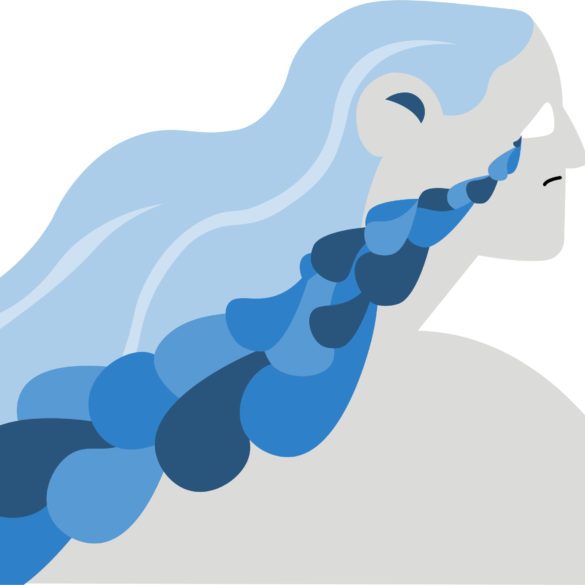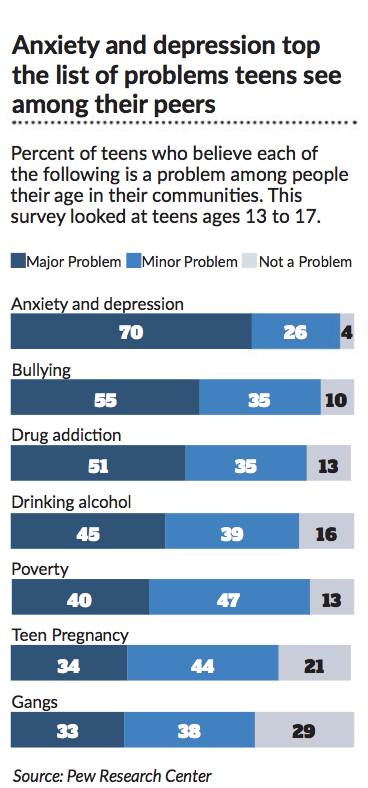Nearly half of college students experience a depressive episode.
Depression — chances are, you or someone you know has battled it at some point.
Research gathered by the American College Health Association shows that 16% of college students report that depression has had a negative impact on their academic performance.
Maybe you’ve experienced a bout of feeling blue, lasting a short period of time, or clinical depression, lasting longer than two weeks.
A survey by The American College Health Association reports 40% of U.S. college students experienced at least one major depressive episode in 2018.
After multiple losses in her family, Grace Georgi, a junior at Ball State University, was diagnosed with unspecified episodic mood disorder, which is characterized by random bouts of mood disturbances, or episodes.
She noticed that she was struggling with school work and she started to distance herself from her peers. It wasn’t until she started taking medication nine years ago and going to therapy that things started to look up for Grace.
“I always say that I’ve been really privileged in the fact that I’ve been able to go to therapy,” Grace says. “I know that some people never even get the opportunity to start therapy.”
But what about feeling blue? Maybe you’ve noticed that when the seasons change, your mood sinks down a bit, but after you adjust, you feel a bit better.
“Most of us experience a down or blue day from time to time, especially when it is cold, dark, and gloomy outside, but we have ways of coping that help to bring us out of this mood,” says Ellen Lucas, associate director of outreach for the Ball State Counseling Center. Lucas has worked at Ball State for 30 years, and she has a doctorate in counseling psychology. Her areas of expertise are eating disorders and career exploration.
Tori Floyd, a junior at Ball State, says she notices that she feels blue more often than she feels depressed.
“I will feel blue from anywhere between two to five days consecutively, and then I’ll have a break for a day or two and the cycle starts again. I don’t know 100% that it’s not depression, but I’m able to pick myself up more often than not,” she says.
Tori says stress is her biggest trigger.
“It can make me feel so lonely. Even when I’m in a room full of people. I feel alone,” she says.
Tori has run into issues trying to schedule a therapy appointment on Ball State’s campus.
“It takes a very long period of time to get into the counseling center, and some people have so much trauma that they don’t want to go back through all of that just so the counselor can understand them and the way they think. Not to mention, right now they are only doing Zoom sessions, and a lot of people need in-person help,” says Tori.
Social media is one avenue people take to openly talk about their mood disorders and mental health. It has even led to new forms of receiving therapy, like virtual sessions with a licensed therapist. However, Grace says social media also can put a damper on her mood.
“I find that social media has helped my mental health in a lot of ways, but it also hurts it. Seeing where my friends are all hanging out without inviting me only makes me feel more isolated and alone, and seeing unrealistic photos of people really hurt me when I was younger and struggling with my body image,” Grace says.
Like Grace, social media is also a cause of insecurity for Tori.
“I’m fairly confident in myself like 80% of the time, but when I have the days I’m not feeling secure, social media doesn’t help,” says Tori.
With more and more people using social media to reach out and find other people who feel like they do comes one large danger: self-diagnosing.
“The danger of self-diagnosing a mental disorder is that you may not be aware of the symptoms or may be minimizing their concerns and symptoms,” says Lucas. “Sometimes people tell themselves ‘It will get better after this test’ and don’t seek help when they need to. Often things can get worse instead of better, so my suggestion is that when in doubt, call the Counseling Center and we can help you to figure out what is going on and suggest services to help you to cope and feel better.”
Lucas says the Counseling Center is only able to offer virtual appointments at this time, but they also offer virtual group counseling, outreach programs, and informational videos on several mood disorders on their website under the “Outreach” tab.
“I also want students to know that if they are struggling with dealing with COVID and all that has come with this pandemic, taking classes virtually, not seeing their friends and family as often as they would want, not having the activities they usually have, and not having fall break, we are here to help them through this,” Lucas says.
“You deserve to feel better,” says Grace. “Feeling sad all the time, or losing interest in things you love, or even avoiding assignments is not normal. That is not part of the college experience. You deserve to get better. I know it feels like this is permanent, like this is the only way you’ll ever feel, but it gets better.”
If you or anyone that you know is struggling with depression or feeling blue, below are some resources available to Ball State students, faculty, and staff.
Counseling Center
Lucina Hall, Room 320
Muncie, IN 47306
765-285-1736
https://www.bsu.edu/campuslife/counselingcenter
National Suicide Prevention Hotline: 1-800-273-TALK
http://suicidepreventionlifeline.org/
Crisis Text Line: text “GO” to 741741
http://www.crisistextline.org/textline/
Meridian Health Services Crisis Line: 800-333-2647 or 765-286-1695
Delaware County and Muncie community mental health agency
https://www.meridianhs.org/Contact





